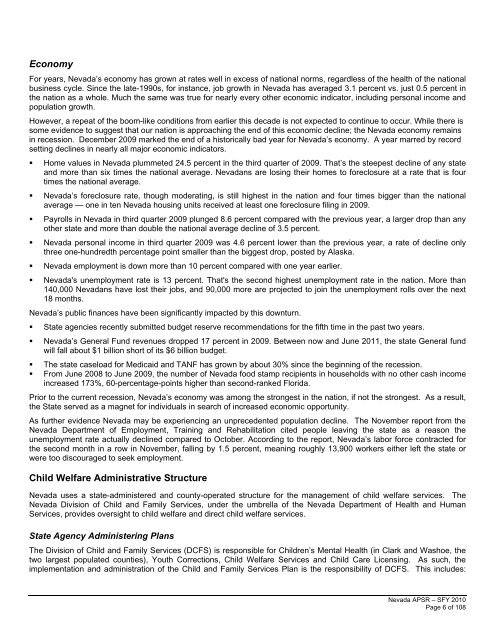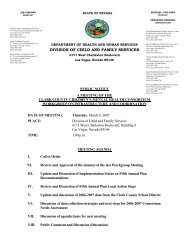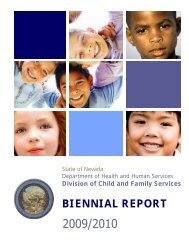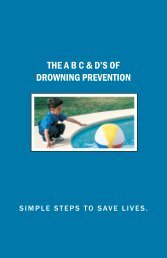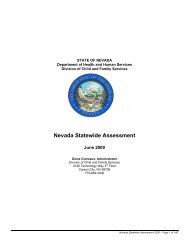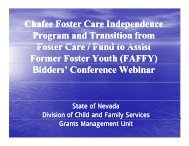STATE OF NEVADA - Division of Child and Family Services
STATE OF NEVADA - Division of Child and Family Services
STATE OF NEVADA - Division of Child and Family Services
You also want an ePaper? Increase the reach of your titles
YUMPU automatically turns print PDFs into web optimized ePapers that Google loves.
Economy<br />
For years, Nevada’s economy has grown at rates well in excess <strong>of</strong> national norms, regardless <strong>of</strong> the health <strong>of</strong> the national<br />
business cycle. Since the late-1990s, for instance, job growth in Nevada has averaged 3.1 percent vs. just 0.5 percent in<br />
the nation as a whole. Much the same was true for nearly every other economic indicator, including personal income <strong>and</strong><br />
population growth.<br />
However, a repeat <strong>of</strong> the boom-like conditions from earlier this decade is not expected to continue to occur. While there is<br />
some evidence to suggest that our nation is approaching the end <strong>of</strong> this economic decline; the Nevada economy remains<br />
in recession. December 2009 marked the end <strong>of</strong> a historically bad year for Nevada’s economy. A year marred by record<br />
setting declines in nearly all major economic indicators.<br />
• Home values in Nevada plummeted 24.5 percent in the third quarter <strong>of</strong> 2009. That’s the steepest decline <strong>of</strong> any state<br />
<strong>and</strong> more than six times the national average. Nevadans are losing their homes to foreclosure at a rate that is four<br />
times the national average.<br />
• Nevada’s foreclosure rate, though moderating, is still highest in the nation <strong>and</strong> four times bigger than the national<br />
average — one in ten Nevada housing units received at least one foreclosure filing in 2009.<br />
• Payrolls in Nevada in third quarter 2009 plunged 8.6 percent compared with the previous year, a larger drop than any<br />
other state <strong>and</strong> more than double the national average decline <strong>of</strong> 3.5 percent.<br />
• Nevada personal income in third quarter 2009 was 4.6 percent lower than the previous year, a rate <strong>of</strong> decline only<br />
three one-hundredth percentage point smaller than the biggest drop, posted by Alaska.<br />
• Nevada employment is down more than 10 percent compared with one year earlier.<br />
• Nevada's unemployment rate is 13 percent. That's the second highest unemployment rate in the nation. More than<br />
140,000 Nevadans have lost their jobs, <strong>and</strong> 90,000 more are projected to join the unemployment rolls over the next<br />
18 months.<br />
Nevada’s public finances have been significantly impacted by this downturn.<br />
• State agencies recently submitted budget reserve recommendations for the fifth time in the past two years.<br />
• Nevada’s General Fund revenues dropped 17 percent in 2009. Between now <strong>and</strong> June 2011, the state General fund<br />
will fall about $1 billion short <strong>of</strong> its $6 billion budget.<br />
• The state caseload for Medicaid <strong>and</strong> TANF has grown by about 30% since the beginning <strong>of</strong> the recession.<br />
• From June 2008 to June 2009, the number <strong>of</strong> Nevada food stamp recipients in households with no other cash income<br />
increased 173%, 60-percentage-points higher than second-ranked Florida.<br />
Prior to the current recession, Nevada’s economy was among the strongest in the nation, if not the strongest. As a result,<br />
the State served as a magnet for individuals in search <strong>of</strong> increased economic opportunity.<br />
As further evidence Nevada may be experiencing an unprecedented population decline. The November report from the<br />
Nevada Department <strong>of</strong> Employment, Training <strong>and</strong> Rehabilitation cited people leaving the state as a reason the<br />
unemployment rate actually declined compared to October. According to the report, Nevada’s labor force contracted for<br />
the second month in a row in November, falling by 1.5 percent, meaning roughly 13,900 workers either left the state or<br />
were too discouraged to seek employment.<br />
<strong>Child</strong> Welfare Administrative Structure<br />
Nevada uses a state-administered <strong>and</strong> county-operated structure for the management <strong>of</strong> child welfare services. The<br />
Nevada <strong>Division</strong> <strong>of</strong> <strong>Child</strong> <strong>and</strong> <strong>Family</strong> <strong>Services</strong>, under the umbrella <strong>of</strong> the Nevada Department <strong>of</strong> Health <strong>and</strong> Human<br />
<strong>Services</strong>, provides oversight to child welfare <strong>and</strong> direct child welfare services.<br />
State Agency Administering Plans<br />
The <strong>Division</strong> <strong>of</strong> <strong>Child</strong> <strong>and</strong> <strong>Family</strong> <strong>Services</strong> (DCFS) is responsible for <strong>Child</strong>ren’s Mental Health (in Clark <strong>and</strong> Washoe, the<br />
two largest populated counties), Youth Corrections, <strong>Child</strong> Welfare <strong>Services</strong> <strong>and</strong> <strong>Child</strong> Care Licensing. As such, the<br />
implementation <strong>and</strong> administration <strong>of</strong> the <strong>Child</strong> <strong>and</strong> <strong>Family</strong> <strong>Services</strong> Plan is the responsibility <strong>of</strong> DCFS. This includes:<br />
Nevada APSR – SFY 2010<br />
Page 6 <strong>of</strong> 108


